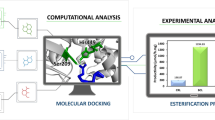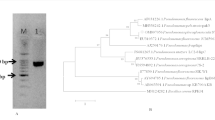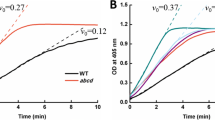Abstract
The resolutions of racemic diastereomeric mixtures of menthyl propionate was performed by Pseudomonas alcaligenes lipase (PaL) to produce (2S, 5R) L-menthol. Because of the inherently low diastereopreference of PaL, covalent docking and molecular dynamic (MD) simulations were used to investigate possible avenues of improvement. Rational site-directed mutagenesis of PaL revealed residues V180 and A272 to be the hotspots for diastereopreference. The double V180L/A272F mutant exhibited the highest degree of diastereopreference, as the diastereomeric ratio of (2S, 5R) L-menthol increased towards both (2R, 5S) L-neomenthol (dr1) and (2R, 5R) D-isoneomenthol (dr2) (diastereomeric ratios dr1 and dr2 increased to 4.65 and 2.13 times that of wild-type PaL). MD simulation analysis indicated that these mutations decrease the flexibility of the surrounding protein regions. The combination of increased steric exclusion and decreased flexibility results in less favorable binding of the non-target substrates, (2R, 5S) L-neomenthyl propionate and (2R, 5R) D-isoneomenthyl propionate, to the V180L/A272F mutant. These results confirmed and further improved our previously proposed model of the diastereomer recognition mechanism based on the combined effect of steric exclusion and regional flexibility.
Similar content being viewed by others
References
Rogalska, E., S. Ransac, and R. Verger (1993) Controlling lipase stereoselectivity via the surface pressure. J. Biol. Chem. 2: 792–794.
Bassegoda, A., F. I. J. Pastor, and P. Diaz (2012) Rhodococcus sp. strain CR-53 LipR, the first member of a new bacterial lipase family (family X) displaying an unusual Y-type oxyanion hole, similar to the Candida antarctica lipase clan. Appl. Environ. Microbiol. 78: 1724–1732.
Berglund, P. (2001) Controlling lipase enantioselectivity for organic synthesis. Biomol. Eng. 18: 13–22.
Tan, T. W., M. Zhang, B. W. Wang, C. H. Ying, and L. Deng (2003) Screening of high lipase producing Candida sp. and production of lipase by fermentation. Proc. Biochem. 39: 459–465.
Zheng, G. W., H. L. Yu, J. D. Zhang, and J. H. Xu (2009) Enzymatic production of l-menthol by a high substrate concentration tolerable esterase from newly isolated Bacillus subtilis ECU0554. Adv. Synth. Catal. 351: 405–414.
Piamtongkam, R., S. Duquesne, F. Bordes, S. Barbe, I. Andre, A. Marty, and W. Chulalaksananukul (2011) Enantioselectivity of Candida rugosa lipases (Lip1, Lip3, and Lip4) towards 2-bromo phenylacetic acid octyl esters controlled by a single amino acid. Biotechnol. Bioeng. 108: 1749–1756.
Wang, P. Y., C. H. Wu, J. F. Chou, A. C. Wu, and S. W. Tsai (2010) Kinetic resolution of (R,S)-pyrazolides containing substituents in the leaving pyrazole for increased lipase enantioselectivity. J. Mol. Catal. B-Enzym. 66: 113–119.
Yao, C. J., Y. Cao, S. S. Wu, S. Li, and B. F. He (2013) An organic solvent and thermally stable lipase from Burkholderia ambifaria YCJ 01: Purification, characteristics and application for chiral resolution of mandelic acid. J. Mol. Catal. B-Enzym. 85–86: 105–110.
Zheng, G. W., J. Pan, H. L. Yu, M. Ngo-Thi, C. X. Li, and J. H. Xu (2010) An efficient bioprocess for enzymatic production of l-menthol with high ratio of substrate to catalyst using whole cells of recombinant E. coli. J. Biotechnol. 150: 108–114.
Zheng, R. C., A. P. Li, and Z. M. Wu (2012) Enzymatic production of (S)-3-cyano-5-methylhexanoic acid ethyl ester with high substrate loading by immobilized Pseudomonas cepacia lipase. Tetrahedron-Asymm. 23: 1517–1521.
Bordes, F., E. Cambon, V. Dossat-Letisse, I. Andre, C. Croux, J. M. Nicaud, and A. Marty (2009) Improvement of Yarrowia lipolytica lipase enantioselectivity by using mutagenesis targeted to the substrate binding site. ChemBiochem. 10: 1705–1713.
Guieysse, D., J. Cortes, S, Puech-Guenot, S. Barbe, V. Lafaquiere, P. Monsan, T. Simeon, I. Andre, and M. Remaud-Simeon (2007) A structure-controlled investigation of lipase enantioselectivity by a path-planning approach. ChemBiochem. 9: 1308–1317.
Fuji, K. (1993) Asymmeric creation of quaternary carbon centers. Chem. Rev. 93: 2037–2066.
Kazlauskas, R. J., A. N. E. Weissfloch, A. T. Rappaport, and L. A. Cuccia (1991) A rule to predict which enantiomer of a secondary alcohol reacts faster in reactions catalyzed by cholesterol esterase, lipase from Pseudomonas cepacia, and lipase from Candida rugosa. J. Org. Chem. 56: 2656–2665.
Schulz, T., R. D. Schmid, and J. Pleiss (2001) Structural basis of stereoselectivity in Candida rugosa lipase catalyzed hydrolysis of secondary alcohols. J. Mol. Model. 7: 265–270.
Schulz, T., J. Pleiss, and R. D. Schmid (2000) Stereoselectivity of Pseudomonas cepacia lipase toward secondary alcohols: A quantitative model. Protein Sci. 9: 1053–1062.
Arun, K. G. and J. H. Kim (2003) Highly diastereoselective anti- Aldol Reactions utilizing the titanium Enolate of cis-2-Arylsul fonamido-1-acenaphthenyl propionate. Org. Lett. 7: 1063–1066.
Nikos, S. H. and S. Ioulia (2004) Enantioselectivity and diastereoselectivity in the transesterification of secondary alcohols mediated by feruloyl esterase from Humicola insolens. Tetrahedron Lett. 13: 2755–2757.
Sun, M. M., H. Chen, J. P. Wu, and L. R. Yang (2012) Cloning, expression and characterization of lipase from Pseudomonas alcaligenes. Weishengwuxue Tongbao. 39: 1580–1588.
Bradya, D., S. Reddya, B. Mboniswaa, L. H. Steenkampa, A. L. Rousseaua, C. J. Parkinsona, J. Chaplina, R. K. Mitraa, T. Moutlanaa, S. F. Maraisa, and N. S. Gardinera (2012) Biocatalytic enantiomeric resolution of l-menthol from an eight isomeric menthol mixture through transesterification. J. Mol. Catal. BEnzym. 75: 1–10.
Bornscheuer, U. T. and M. Pohl (2001) Improved biocatalysts by directed evolution and rational protein design. Cur. Opin. Chem. Biol. 5: 137–143.
Chen, H., J. P. Wu, L. R. Yang, and G. Xu (2013) A combination of site-directed mutagenesis and chemical modification to improve diastereopreference of Pseudomonas alcaligenes lipase. Biochim. Biophys. Acta. 1834: 2494–2501.
Becker, P., I. Abu-Reesh, S. Markossian, G. A. Antranikian, and H. Markl (1997) Determination of the kinetic parameters during continuous cultivation of the lipase-producing thermophile Bacillus sp. IHI-91 on olive oil. Appl. Microbiol. Biot. 48: 184–190.
Imberty, A., V. Piller, F. Piller, and C. Breton (1997) Fold recognition and molecular modelling of a lectin-like domain in UDP-GalNAc: Polypeptide N-acetylgalactosaminyl transferases. Protein Eng. 10: 1353–1356.
Kinney, W. A., Jr H. R. Almond, J. Qi, C. E. Smith, R. J. Santulli, L. Garavilla, P. Andrade-Gordon, D. S. Cho, A. M. Everson, M. A. Feinstein, P. A. Leung, and B. E. Maryanoff (2002) Structure-function analysis of urotensin II and its use in the construction of a ligand-receptor working model. Angew. Chem. 41: 2940–2944.
Laskowski, R. A., M. W. MacArthur, D. S. Moss, and J. M. Thornton (1993) PROCHECK: A program to check the stereochemical quality of protein structure. J. Appl. Crystallogr. 26: 283–291.
Jakalian, A., B. L. Bush, D. B. Jack, and C. I. Bayly (2000) Fast, efficient generation of high-quality atomic charges. AM1-BCC Model: I. Method. J. Comput. Chem. 21: 132–146.
Jorgensen, W. L. (1982) Revised TIPS for simulations of liquid water and aqueous solutions. J. Chem. Phys. 77: 4156–4163.
Jorgensen, W. L., J. Chandrasekhar, J. D. Madura, R. W. Impey, and M. L. Klein (1983) Comparison of simple potential functions for simulating liquid water. J. Chem. Phys. 79: 926–935.
Darden, T., D. York, and L. Pedersen (1993) Particle mesh Ewald: An NLog(N) method for Ewald sums in large systems. J. Chem. Physi. 98: 10089–10092.
Miyamoto, S. and P. A. Kollman (1992) SETTLE: An analytical version of the SHAKE and RATTLE: An analytical version of the SHAKE and RATTLE algorithm for rigid water models. J. Comput. Chem. 13: 952–962.
Kollman, P. A., I. Massova, C. Reyes, B. Kuhn, S. Huo, L. Chong, M. Lee, T. Lee, Y. Duan, W. Wang, O. Donini, P. Cieplak, J. Srinivasan, D. A. Case, and T. E. Cheatham (2000) Calculating structures and free energies of complex molecules: Combining molecular mechanics and continuum models. Acc. Chem. Res. 33: 889–897.
Hou, T. J., J. M. Wang, Y. Y. Li, and W. Wang (2011) Assessing the performance of the MM/PBSA methods. 1. The accuracy of binding free energy calculations based on molecular dynamics simulations. J. Chem. Inf. Model. 51: 69–82.
Larsen, N. A., J. M. Turner, J. Stevens, S. J. Rosser, A. Basran, and R. A. Lerner (2002) Crystal structure of a bacterial cocaine esterase. Nat. Struct. Biol. 9: 17–21.
Gohlke, H., C. Kiel, and D. A. Case (2003) Insights into protein — CProtein binding by binding free energy calculation and free energy decomposition for the Ras — CRaf and Ras — CRalGDS complexes. J. Mol. Boil. 330: 891–913.
Kamal, J. K. A. and V. B. Digambar (2003) Activity, stability and conformational flexibility of seed coar soybean peroxidise. J. Inorg. Biochem. 94: 236–242.
Maria, S. C., G. M. Guillermo, and D. F. Gerardo (2003) Protein stability induced by ligand binding correlates with changes in protein flexibility. Protein Sci. 12: 1496–1506.
Peters, G. H. and R. P. Bywater (1999) Computational analysis of chain flexibility and fluctuations in Rhizomucor miehei lipase. Protein Sci. 12: 747–754.
Broos, J., A. J. W. G. Visser, J. F. J. Engbersen, W. Verboom, van A. Hoek, and D. N. Reinhoudt (1997) Flexibility of enzymes suspended in organic solvents probed by time-resolved fluorescence anisotropy. Evidence that enzyme activity and enantioselectivity are directly related to enzyme flexibility. J. Am. Chem. Soc. 117: 12657–12663.
Rariy, R. V. and A. M. Klibanov (2000) On the relationship between enzymetic enantioselectivity in organic solvents and enzyme flexibility. Biocatal. Biotransform. 18: 401–407.
Author information
Authors and Affiliations
Corresponding authors
Rights and permissions
About this article
Cite this article
Chen, H., Wu, JP., Yang, LR. et al. Improving Pseudomonas alcaligenes lipase’s diastereopreference in hydrolysis of diastereomeric mixture of menthyl propionate by site-directed mutagenesis. Biotechnol Bioproc E 19, 592–604 (2014). https://doi.org/10.1007/s12257-014-0066-9
Received:
Revised:
Accepted:
Published:
Issue Date:
DOI: https://doi.org/10.1007/s12257-014-0066-9




